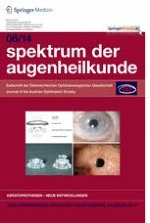Anzeige
01.12.2014 | original article
Four-year outcomes and complications of Boston keratoprosthesis type I implantation in the Middle East
Erschienen in: Spektrum der Augenheilkunde | Ausgabe 6/2014
Einloggen, um Zugang zu erhaltenSummary
Objective
The objective of this study was to present 4-year outcomes and complications after Boston keratoprosthesis (B-KPro) type I implantation in patients from the Middle East region.
Material and methods
In total, 16 eyes of 16 patients (mean age: 56.3 ± 4.1 years), who had undergone B-KPro type I implantation and completed 4 years of follow-up, were retrospectively reviewed.
Results
B-KPro was performed as a secondary procedure in 50 % (8 of 16) of the eyes due to prior graft failure and primary procedure in 50 % (8 of 16) of the eyes, including two eyes with ocular cicatricial pemphigoid, one eye with chemical burn, and five eyes with severe corneal vascularization due to trachoma. Preoperative comorbidities included glaucoma in 56.3 % (9 of 16) of the eyes. Corneal melts developed in three eyes postoperatively. Other complications included retroprosthetic membrane (RPM) in 50 % (8 of 16), worsening of glaucoma in 18.8 % (3 of 16), vitreous hemorrhage in 12.5 % (2 of 16), and sterile vitritis in 6.3 % (1 of 16) of the eyes. The retention rate in the current study was 81.3 % (13 of 16), with a visual acuity of ≥ 20/200 in 68.8 % (11 of 16) of the eyes at 4-year follow-up.
Conclusions
After a long-term follow-up of 4 years, B-KPro type I implantation improved and maintained vision, both as a secondary procedure in patients with multiple graft failures and primary procedure in conditions with poor prognosis for corneal transplantation. However, the outcomes in cases with autoimmune disorders are less favorable. The retention rate found in the current case series is in agreement with previous reports from the Middle East as well as the other parts of the world.
